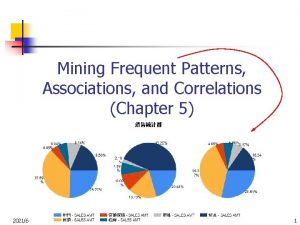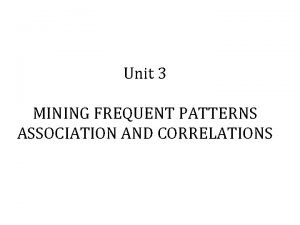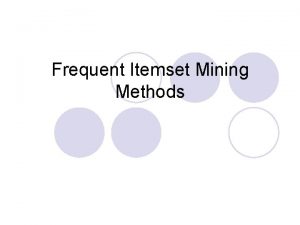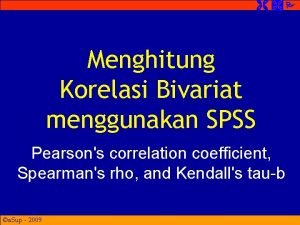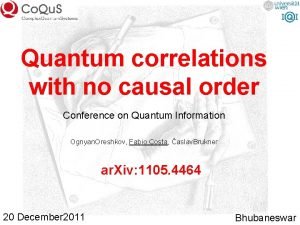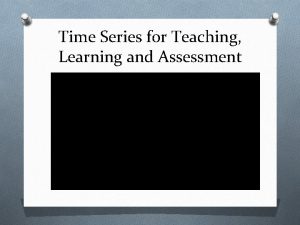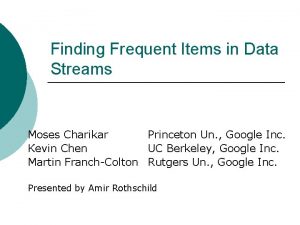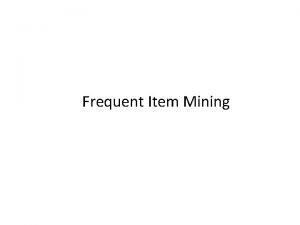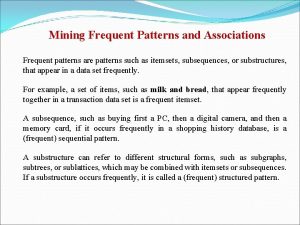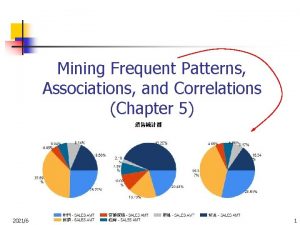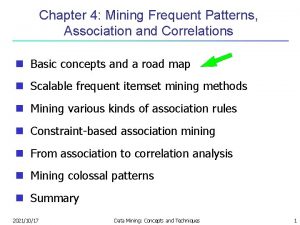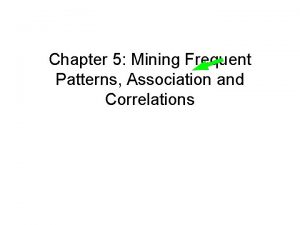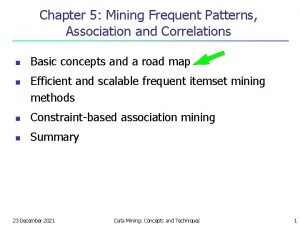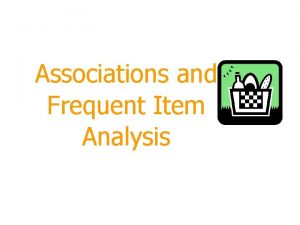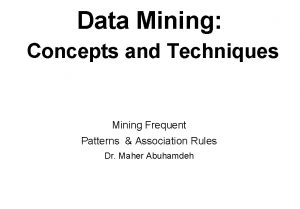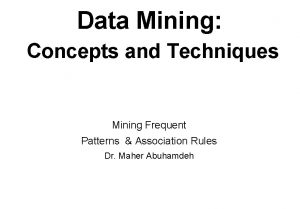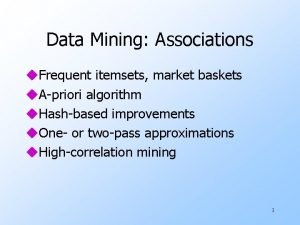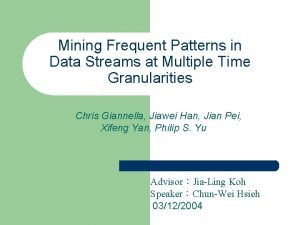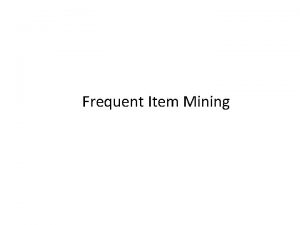Data Mining Mining Frequent Patterns Associations and Correlations




















- Slides: 20

Data Mining, Mining Frequent Patterns, Associations and Correlations ﺩکﺘﺮ ﻓﺎﻃﻤﻪ ﺍﺣﻤﺪی آﺒکﻨﺎﺭی 1


Apriori: Example C 1 List of Item_Ids T 100 I 2, I 1, I 5 T 200 I 2, I 4 T 300 I 2, I 3 T 400 I 2, I 1, I 4 T 500 I 1, I 3 T 600 I 2, I 3 T 700 I 1, I 3 T 800 I 2, I 1, I 3, I 5 T 900 I 2, I 1, I 3 Minimum Support count: 2 Compare with minimum support count Transaction _ Id Itemset Sup. Count {I 1} 6 {I 2} 7 {I 3} 6 {I 4} 2 {I 5} 2 L 1 Itemset Sup. Count {I 1} 6 {I 2} 7 {I 3} 6 {I 4} 2 {I 5} 2 3

Apriori: Example Itemset Sup. Count {I 1, I 2} 4 {I 1, I 3} 4 {I 1, I 5} 2 2 {I 2, I 3} 4 {I 2, I 4} 2 {I 2, I 5} 2 {I 3, I 4} 0 {I 3, I 5} 1 {I 4, I 5} 0 Itemset Sup. Count {I 1, I 2} 4 {I 1, I 3} 4 {I 1, I 4} 1 {I 1, I 5} C 2 Compare with minimum support count L 2 {I 1, I 2, I 3}: {I 1, I 2}, {I 1, I 3}, {I 2, I 3}ε L 2 in C 3 {I 2, I 3, I 5}: {I 2, I 3}, {I 2, I 5}, {I 3, I 5} ε L 2 not in C 3 {I 1, I 2, I 3, I 5}: {I 1, I 2, I 3}, {I 1, I 2, I 5}, {I 2, I 3, I 5} ε L 3 not in C 4 Finish Itemset Sup. Count {I 1, I 2, I 3} 2 {I 1, I 2, I 5} 2 C 3 Compare with minimum support count Itemset Sup. Count {I 1, I 2, I 3} 2 {I 1, I 2, I 5} 2 L 3 4


Association Rules 1: 2: 3: 4: 5: 6: {I 1, I 2} {I 5} Confidence: 2/4 = 50% {I 1, I 5} {I 2} Confidence : 2/2 = 100% {I 2, I 5} {I 1} Confidence : 2/2 = 100% {I 1} {I 2, I 5} Confidence : 2/6 = 33% {I 2} {I 1, I 5} Confidence : 2/7 = 29% {I 5} {I 1, I 2} Confidence : 2/2 = 100% Minimum Confidence Threshold: 70% Strong Association Rules 2: {I 1, I 5} {I 2} Confidence : 2/2 = 100% 3: {I 2, I 5} {I 1} Confidence : 2/2 = 100% 6: {I 5} {I 1, I 2} Confidence : 2/2 = 100% Unlike conventional classification rules, Association rules can contain more than one conjunction at the right-hand side of the rule. 6


FP-Growth Transaction _ Id List of Item_Ids T 100 I 2, I 1, I 5 T 200 I 2, I 4 T 300 I 2, I 3 T 400 I 2, I 1, I 4 T 500 I 1, I 3 T 600 I 2, I 3 T 700 I 1, I 3 T 800 I 2, I 1, I 3, I 5 T 900 I 2, I 1, I 3 {} I 2: 7 I 1: 4 I 5: 1 I 1: 2 I 3: 2 I 4: 1 I 5: 1 8

FP-Growth ﻣﺴﻴﺮﻫﺎی پﻴﺸﻮﻧﺪی ( )ﺍﺯ ﺩﺭﺧﺖ Item ﺭﺧﺪﺍﺩ پﻴﺸﻮﻧﺪﻫﺎ ﺑﺎ ﻣﺮﺍﺟﻌﻪ ﺑﻪ ﺟﺪﻭﻝ Conditional Pattern Conditional FP-Tree Base ﺍﻟگﻮﻫﺎی ﺗﻮﻟﻴﺪ ﺷﺪﻩ ﺑﺎ ﺍﺳﺘﻔﺎﺩﻩ ﺍﺯ ﺳﺘﻮﻥ ﻣﺠﺎﻭﺭ Frequent Pattern Generated I 5 {{I 2, I 1: 1}, {I 2, I 1, I 3: 1}} {I 2: 2, I 1: 2} {I 2, I 5: 2}, {I 1, I 5: 2}, {I 2, I 1, I 5: 2} I 4 {{I 2, I 1: 1}, {I 2: 1}} {I 2: 2} {I 2, I 4: 2} I 3 {{I 2, I 1: 1}, {I 2: 2}, {I 1: 2}} {I 2: 4}, {I 1: 2}, {I 2, I 1: 2} {I 2, I 3: 4}, {I 1, I 3: 4}, {I 2, I 1, I 3: 2} I 1 {{I 2: 2}} {I 2: 4} {I 2, I 1: 4} Mining the FP-tree by creating conditional (sub-) pattern bases 9


Eclat (Equivalence Class Transform) Transaction _ Id List of Item_Ids T 100 I 2, I 1, I 5 T 200 I 2, I 4 T 300 I 2, I 3 T 400 I 2, I 1, I 4 T 500 I 1, I 3 T 600 I 2, I 3 T 700 I 1, I 3 Itemset TID_Set T 800 I 2, I 1, I 3, I 5 I 1 {T 100, T 400, T 500, T 700, T 800, T 900} T 900 I 2, I 1, I 3 I 2 {T 100, T 200, T 300, T 400, T 600, T 800, T 900} I 3 {T 300, T 500, T 600, T 700, T 800, T 900} I 4 {T 200, T 400} I 5 {T 100, T 800} 1 11

Eclat (Equivalence Class Transform) Itemset TID_Set {I 1, I 2} {T 100, T 400, T 800, T 900} {I 1, I 3} {T 500, T 700, T 800, T 900} {I 1, I 4} {T 400} {I 1, I 5} {T 100, T 800} {I 2, I 3} {T 300, T 600, T 800, T 900} {I 2, I 4} {T 200, T 400} {I 2, I 5} {T 100, T 800} {I 3, I 4} {} {I 3, I 5} {T 800} {I 4, I 5} {} Itemset TID_Set {I 1, I 2, I 3} {T 800, T 900} {I 1, I 2, I 5} {T 100, T 800} 2: The 2 -itemsets Minimum Support count: 2 3: The 3 -itemsetd 12


Correlation Analysis using Lift A B {Support, Confidence, Correlation} C_Game ∑row V_Game 4000 3500 7500 V_Game 2000 500 2500 ∑col 6000 4000 10000 Contingency Table (Confidence (A B) / Support (B)) = P(B|A) / P(B) Because the result of Lift is less than one, so there is a negative correlation between the occurrence of C_Game and V_Game which could not be discovered with Support and Confidence values. 14

Correlation Analysis using χ2 C_Game ∑row V_Game 4000 3500 7500 V_Game 2000 500 2500 ∑col 6000 4000 10000 C_Game ∑row V_Game 4000 (4500) 3500 (3000) 7500 V_Game 2000 (1500) 500 (1000) 2500 ∑col 6000 4000 10000 Contingency Table 15

Other Correlation Measures 1 2 3 or Harmonized Lift 4 The results of All measures is between zero and one. If it is close to one, A and B are positively correlated and if the result id less than 0. 5 they are negatively correlated. 16

Correlation Measures: Comparison Milk ∑row Coffee MC MC C ∑col M M ∑ D MC MC χ2 Lift All. Conf Max_ Kulcz Conf Cosine D 1 10000 100000 90557 9. 26 0. 91 D 2 10000 1000 100 0 1 0. 91 D 3 100000 670 8. 44 0. 09 D 4 100000 24740 25. 75 0. 5 D 5 10000 100000 8173 9. 18 0. 09 0. 91 0. 5 0. 29 D 6 1000 10 100000 965 1. 97 0. 01 0. 91 0. 5 0. 10 17


Correlation Measures: Comparison IR represent the imbalance between A and B Itemset in a way that the more the difference between A and B, the more their imbalance ratio. Usage of Imbalance Ratio (IR) and Kulczynski make better view of D 4 to D 6 Datasets. 19

 Associations and correlations in data mining
Associations and correlations in data mining Associations and correlations in data mining
Associations and correlations in data mining Mining frequent patterns associations and correlations
Mining frequent patterns associations and correlations Dbminer
Dbminer Mining frequent patterns without candidate generation
Mining frequent patterns without candidate generation Apriori algorithm
Apriori algorithm Eck
Eck Korelasi bivariat
Korelasi bivariat Quantum correlations with no causal order
Quantum correlations with no causal order Spurious correlations
Spurious correlations Illusory correlations ______.
Illusory correlations ______. Mining multimedia databases in data mining
Mining multimedia databases in data mining Finding frequent items in data streams
Finding frequent items in data streams What is kdd process in data mining
What is kdd process in data mining Data mining dan data warehouse
Data mining dan data warehouse Olap in data mining
Olap in data mining Introduction to data mining and data warehousing
Introduction to data mining and data warehousing Difference between strip mining and open pit mining
Difference between strip mining and open pit mining Web text mining
Web text mining Penyebab penyakit benign neoplasm of breast d24
Penyebab penyakit benign neoplasm of breast d24 Zscore
Zscore
